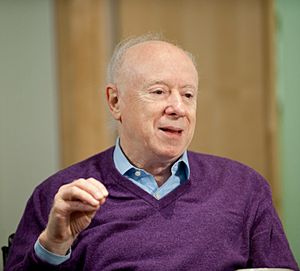Joseph L. Goldstein facts for kids
Quick facts for kids
Joseph L. Goldstein
|
|
|---|---|
 |
|
| Born |
Joseph Leonard Goldstein
April 18, 1940 |
| Education |
|
| Known for | cholesterol |
| Awards |
|
| Scientific career | |
| Fields | Biochemistry |
| Institutions | University of Texas Southwestern Medical Center |
Joseph Leonard Goldstein is an American biochemist born on April 18, 1940. He is famous for his important work on cholesterol. In 1985, he won the Nobel Prize in Physiology or Medicine with his research partner, Michael Brown. They discovered how human cells control cholesterol levels.
Their research showed that our cells have special "receptors" that grab low-density lipoprotein (LDL), which carries cholesterol, from the blood. If a person doesn't have enough of these receptors, too much cholesterol stays in their blood. This can lead to health problems like coronary heart disease. Their discoveries were a big step forward and helped create medicines called statins, which help lower cholesterol.
Contents
Early Life and Education
Joseph Goldstein grew up in Kingstree, South Carolina. His parents, Fannie and Isadore E. Goldstein, owned a clothing store. He went to Washington and Lee University and earned his science degree in 1962. Later, he studied medicine at the University of Texas Southwestern Medical Center and became a doctor in 1966.
After finishing his medical training, Goldstein worked at the National Institutes of Health (NIH) in Maryland. There, he focused on molecular biology, which studies how tiny parts of cells work. In 1972, he returned to the University of Texas Southwestern Medical Center. He became the head of the Medical Genetics division.
Groundbreaking Cholesterol Research
At the Southwestern Medical Center, Joseph Goldstein began working closely with Michael Brown. Brown was also a researcher who had worked at the NIH. From 1973 to 1985, Goldstein and Brown published many important scientific papers together. They were recognized as highly influential scientists. Even though they could have taken big leadership roles, both chose to keep doing hands-on research.
Their most famous discovery was about how cells manage cholesterol. They found that cells have special "docking stations" called LDL receptors. These receptors are like tiny magnets that pull LDL cholesterol out of the blood. If these receptors don't work well or there aren't enough of them, cholesterol builds up in the blood. This can cause serious health issues. Their work explained why some people have very high cholesterol levels. It also led to the development of statin drugs, which are now widely used to help control cholesterol.
Continuing Discoveries and Mentorship
After their Nobel-winning work, Goldstein and Brown continued their research. In 1993, their team discovered a group of proteins called SREBPs. These proteins help control how cells make and use fats and cholesterol. They found out how these SREBPs are released inside cells to turn on genes that make fats. This process is carefully controlled, helping cells keep the right balance of fats and cholesterol.
Joseph Goldstein is currently the chair of Molecular Genetics at the University of Texas Southwestern Medical Center. He and Michael Brown lead a research team that includes many talented students and researchers. They have trained over 145 scientists. Many of their former students have become very successful. For example, Thomas C. Südhof won the Nobel Prize in Medicine in 2013, and Helen H. Hobbs received the Breakthrough Prize in Life Sciences in 2015.
Goldstein has received many other honors for his work. In 1988, he was given the U.S. National Medal of Science. In 2003, he and Brown won the Albany Medical Center Prize. This award recognized their continued work on cholesterol and their discovery of a regulator that might help treat diabetes mellitus. He is also a member of important scientific groups like the U.S. National Academy of Sciences.
Science and Art
Joseph Goldstein has also shown an interest in the connection between science and art. Since 2000, he has written essays about how science is a creative activity, much like art. These essays have appeared in scientific journals like Nature Medicine. He also served as the chairman for the jury of the Albert Lasker Medical Research Awards, which are very prestigious science awards.
Awards and Honors
Joseph L. Goldstein has received many important awards for his scientific contributions:
- 2011 – Stadtman Distinguished Scientist Award
- 2007 – Builders of Science Award
- 2005 – Woodrow Wilson Awards for Public Service
- 2005 – Herbert Tabor Award
- 2003 – Albany Medical Center Prize in Medicine and Biomedical Research
- 2002 – Kober Medal
- 1999 – Warren Alpert Foundation Prize
- 1991 – Elected a Foreign Member of the Royal Society
- 1988 – U.S. National Medal of Science
- 1987 – Elected member of the American Philosophical Society
- 1986 – Golden Plate Award of the American Academy of Achievement
- 1985 – Nobel Prize in Physiology or Medicine
- 1985 – Albert Lasker Award for Basic Medical Research
- 1985 – William Allan Award
- 1984 – Louisa Gross Horwitz Prize
- 1981 – Gairdner Foundation International Award
- 1981 – Elected member of the American Academy of Arts and Sciences
- 1980 – Elected member of the National Academy of Sciences
- 1979 – Richard Lounsbery Award
- 1978 – Passano Award
- 1976 – Pfizer Award in Enzyme Chemistry
See also
 In Spanish: Joseph Leonard Goldstein para niños
In Spanish: Joseph Leonard Goldstein para niños
- List of Jewish Nobel laureates

